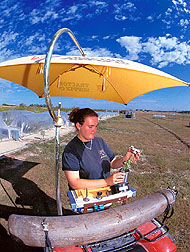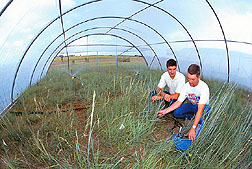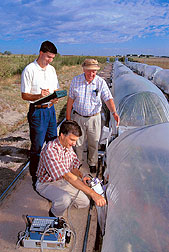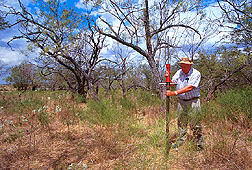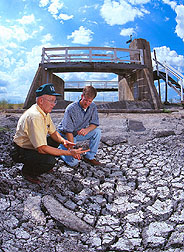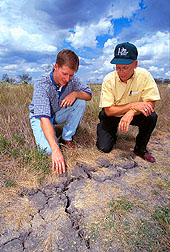Farming and Natural Resources
If you want to see how plants fared during the ice age—and how they might fare in the year 2050—enter the ARS "time machine" in Temple, Texas, in the Blackland Prairie.
During the ice age, Earth's atmospheric carbon dioxide level was roughly half of today's and one-third of that projected for 2050. How will the plants we depend on for survival respond to the future higher CO2 levels?
Tunneling Back to the CO2 Future
The "time machine" is more of a time tunnel—actually two low, parallel, plastic-walled tunnels—with prairie plants growing inside them. But if you could crawl through one tunnel, you would first breathe air having the CO2 levels predicted for the year 2050; that is, 550 parts per million (ppm). When you left this tunnel you'd be back in 1999, with its CO2 level of 350 ppm. On entering the second tunnel, you'd again find yourself in today's CO2 levels. But by the time you left, you'd be in the ice age—13,000 to 18,000 B.C.—when CO2 levels averaged only 200 ppm. Each tunnel is 60 yards long, 1 yard wide, and 1 yard high. Scientists inject enough CO2 in the first tunnel to reach 550 ppm. A fan blows air down the tunnel until the CO2level declines to 350 ppm. In the second tunnel, they introduce outside air with 350 ppm CO2. The CO2 gradually declines to the ice age level of 200 ppm as it moves down the tunnel.
ARS ecologist Hyrum B. Johnson came up with the unique idea of the tunnels, using plants to deplete the air of CO2 as they breathe it in. The fan varies its speed based on what CO2-detecting sensors tell a computer connected to the fan. If the CO2 level at one end drops too much, the fan speeds up.
Temple is 1 of about 80 ARS research locations around the country where research in the agency's natural resources and sustainable agricultural systems program area is done. Allen R. Dedrick, who heads the program, says that "under natural resources, we include resources such as healthy soil, clean air and water, wildlife, and open spaces. "When we're talking about natural resources potentially affected by agriculture, we need to consider all of this country's 3 million-plus square miles of land," says Dedrick. "ARS seeks to enhance the quality of the environment through better understanding of and building on agriculture's complex links with soil, water, air, and biological resources. Our research mission boils down to mitigating any possible adverse effects on the environment from animal or plant production."
ARS' CO2 research dates back to 1969, when Lowry A. Harper, at Watkinsville, Georgia, and Donald N. Baker, then an ARS agronomist at Starkville, Mississippi, conducted open-air CO2 studies on cropland. Baker is now retired.
Since then, ARS has expanded its research on the effects of higher CO2 levels and other aspects of climate change. For example, in the late 1980s, ARS began a series of free-air CO2-enrichment (FACE) studies to determine the effects of CO2on crops growing in the field in different parts of the country. The FACE experiments began with cotton in Arizona and Alabama, followed by wheat and grain sorghum.
These open-air studies have confirmed indoor chamber studies that showed that crop yields rise with increasing CO2 levels. Three years of data show that, on average, cotton yields increased between 30 and 40 percent with a doubling of the current CO2 level, while wheat yields rose 10 to 20 percent.
Climate change is one of the latest issues to come to the forefront, but it is far from the only one the ARS natural resources program is addressing.
Protecting Water Resources
Water quality—in terms of contamination by pesticides and nitrogen fertilizer—became an issue in the 1970s. Up until then, water quality had generally referred only to water clouded by eroded soil.
In 1990, ARS took the lead in a USDA water quality program across the Midwest, studying large areas called Management System Evaluation Areas (MSEA). Since then, the MSEA program has expanded beyond the Midwest, to include the Mississippi Delta and the Eastern Coastal Plains. Part of the impetus for the expansion into the Mississippi Delta was the annual appearance of hypoxic "dead zones" in the Gulf of Mexico, caused by the using up of available oxygen by excessive algal blooms.
"The MSEA program has resulted in more efficiency in nitrogen fertilizer use and subsequent reductions in nitrate contamination of water," Dedrick says. For example, farmers in one Iowa watershed study area reduced their nitrogen fertilizer applications by 50 pounds an acre on about 20 percent of the watershed. ARS scientists in the MSEA study areas also developed—and continue to develop—practices and technology that should lead to similar results nationwide. For example, a plant chlorophyll meter that tells farmers how much nitrogen a plant needs has proven valuable in guiding nitrogen applications.
Practices such as ridge tillage have greatly reduced or eliminated leaching of the herbicide atrazine to the water table. Ridge tillage involves growing crops on raised seedbeds, with no tillage between seedbeds.
|
|
Harmful algal blooms such as those causing hypoxic zones in the Gulf and outbreaks of toxic forms of Pfiesteria along the East Coast have brought national attention to the problem of excess nutrients in bodies of water. Nutrient enrichment and subsequent algal blooms are also a concern in freshwaters. While excess nitrogen is usually of major concern in saltwater, phosphorus is more important in freshwater.
Now ARS water quality research also emphasizes phosphorus, the probable cause of these blooms in most freshwaters. Andrew N. Sharpley, an ARS soil scientist in University Park, Pennsylvania, studied phosphorus long before Pfiesteria became a household word in the mid-Atlantic states.
"Over the last 20 years, we have done a good job reducing point sources of pollution with improved water treatment and phosphorus bans in detergent," Sharpley explains. "Now a greater share of phosphorus entering our rivers and lakes comes from nonpoint sources such as agricultural runoff, which are much harder to pinpoint."
Hence the focus on agriculture in general—and on confined animal feeding operations in particular.
Managing Manure
This year, the U.S. Department of Agriculture and the U.S. Environmental Protection Agency proposed a joint strategy to promote more efficient nutrient management, particularly for animal operations. In all of the efforts, attention is being given to the management of phosphorus, as well as nitrogen, in manures.
"Phosphorus runoff has always been a concern, but we worried more about nitrogen because of the direct health effects of high nitrates in drinking water," says Sharpley. "Unlike nitrogen, phosphorus binds tightly to soils. We figured if we stopped runoff and erosion, phosphorus would pretty much stay in place. But we've since learned that when phosphorus builds up to very high levels in soil, it can wash off as dissolved phosphorus, too."
"Unfortunately," says Sharpley, "traditional conservation measures—such as grass buffers we've depended on to catch eroded soil particles—won't stop dissolved forms of phosphorus, which are also the most biologically active."
As a result, Sharpley adds, "we're having to create new practices, such as breeding new varieties of corn for animal feed that have larger amounts of phosphorus in a form that animals can digest or adding phytase to animal feed. Both of these practices can reduce the amount of phosphorus excreted by animals. We are also trying to tie up phosphorus in manure with alum."
Sharpley says that the only permanent solution to reducing soil phosphorus is to balance farm input and output. In other words, farmers should attempt to reduce the amount of phosphorus brought onto a farm as feed and fertilizer, "so that crops and animals are fed as closely as possible only the phosphorus they actually need.
"This is especially important," Sharpley says, "in parts of a watershed that are particularly vulnerable to runoff. Generally, most of the phosphorus running off watersheds comes from only small areas of the land during a few large storms."
Sharpley believes that land application of manure will be based on phosphorus as well as nitrogen in 3 or 4 years. "There is a lack of information on how to develop phosphorus-based manure management plans for farms, but this is a gap we are filling," he says.
Currently, Sharpley is helping USDA's Natural Resources Conservation Service (NRCS) develop a phosphorus index that pinpoints the source areas of phosphorus, the so-called hot spots. He is also coordinating ARS' contribution to a national effort—involving NRCS, universities, and EPA—to assign phosphorus thresholds for a wide range of soil types across the United States by 2002.
The "Blue Revolution"
|
|
For many decades, NRCS—formerly the Soil Conservation Service—has worked closely with ARS and farmers to keep irrigation drainage water from contaminating groundwater and surface water with phosphorus, nitrogen, pesticides, sediment, salt, and toxic concentrations of trace elements like selenium.
Irrigation and drainage have played a critical role in American agriculture and were a driving force in the settlement of the American West. Development of the modern irrigation infrastructure—especially the use of center-pivot sprinklers since 1960—has led to a technological evolution in the application of water to the land. What has been termed the "green revolution" in worldwide food production was in many ways a "blue revolution," as irrigation expanded around the world.
Today, irrigated agriculture in the United States accounts for 40 percent of total crop value—from only 15 percent of total cropland.
"We expect irrigation to continue to expand in the Southeast and the lower Mississippi River Valley," Dedrick says. "But, similar to many of our modern agricultural technologies, irrigation doesn't come without problems." Further, the nation faces changing public values and increasing demands for water for nonagricultural uses, including recreation and urban drinking water.
"As growers adapt to more efficient, effective irrigation and drainage practices to compete in a global economy," says Dedrick, "it's ARS' role to help them do this without harm to the environment or their wallets."
ARS scientists across the country are continually devising improvements in the various forms of irrigation systems used by farmers in different areas—including the increasingly popular center-pivot sprinklers and furrow and drip irrigation.
The improvements include surge valves to conserve water for furrow irrigation, and automation, with some irrigations triggered by high plant leaf temperatures.
In Ohio and Louisiana, scientists are using underground drainage pipes to irrigate when the water table goes down, giving plants ample water all season and less chance for contaminants to move to groundwater.
Because of ARS research, western farmers have stopped millions of tons of topsoil from washing out of irrigation furrows by adding small amounts of a safe, erosion-fighting polyacrylamide powder called PAM to irrigation water.
Safeguarding Soil Resources
|
|
In Morris, Minnesota, researchers are looking at strip tillage, a new tillage system for farmers who want their soils to warm up faster in the spring.
Ward Voorhees, who leads the ARS laboratory in Morris, says that strip tillage involves tilling just the seedbed area, not the entire row. "Since the tilling is limited to a fraction of the land, farmers can till in the fall without fear of erosion over winter," Voorhees says. "This gives the seedbed a chance to warm up sooner in the spring."
Voorhees and his colleagues have shown that the less tillage the better. They have found that 1 year of tillage—any kind of tillage—negates all the benefits of setting land aside to rest as grassland for a decade, under USDA's Conservation Reserve Program to protect highly erodible soils.
"But," Voorhees says, "if you have to till, we've found that you can get as good a crop with minimum tillage—even just enough to plant seeds—as you can with plowing."
Tillage tends to have an adverse effect on soil health, Voorhees says. "Good soil has more organic matter, is less erodible, cycles nutrients more efficiently, and holds more water."
Jerry L. Hatfield, a plant physiologist who directs the ARS National Soil Tilth Laboratory in Ames, Iowa, agrees.
Good soil is better for both air and water quality. By holding in water, it helps plants and reduces surface runoff, which in turn reduces the movement of pesticides and nutrients such as phosphorus toward lakes and rivers.
"Good soil also helps to degrade pesticides, rendering them harmless," Hatfield says. "Whenever we study a farming practice, we check its effects on both soil and environmental quality."
Dedrick reminds us that it all starts with soil.
"That's what farmers do, manage soils. Soil grows the plants that feed people and animals and provide wildlife habitat. It also functions as nature's filter, removing potential contaminants before they enter the air or water. That's why soil is key to the ARS natural resources program," says Hatfield.
"ARS researchers over the years, working with NRCS and universities, have done the supporting research that encouraged farmers to largely put away the moldboard plow—used in breaking out the American West—and reduce erosion by 90 percent on about 40 percent of U.S. planted acres."
"Farmers have also substantially reduced erosion on another 25 percent of those acres with more moderate reductions in tillage," adds Dedrick. "We now hypothesize that this dramatic change in tillage techniques may have shifted U.S. farm soils from net CO2 producers to net accumulators of carbon—in the form of valuable soil organic matter. This would make these soils more productive and part of the potential global warming solution, rather than part of the problem.
"Perhaps our most important contribution to reducing soil erosion was the development, in the 1950s, of erosion prediction formulas that have enabled natural resource managers around the world to identify erodible soils and the practices that control erosion from water and wind. These formulas," Dedrick says, "have given way to new computer prediction technology that we are developing for the next millennium."
Computers To Enhance Precision
ARS researchers in soil science and other disciplines are excited by the further changes promised by technological advances in computer modeling and precision agriculture. Farmers and scientists are getting used to seeing data generated by on-the-go monitors that show how yields vary from spot to spot in a field, and year to year, as well as data from sensors aboard aircraft, on tractors, and on the ground.
Better computer model software and associated products—including software-based analyses and recommendations—that incorporate the new information and insights researchers have learned about soil will help farmers with everything from reducing nitrate leaching to preventing soil compaction. Farmers, regardless of the size of their operations, can many times use these aids not only for long-term planning, but also for day-to-day decisions. Developing such software is an important goal of ARS' natural resources program.
The Issue of Scale
Hatfield and his colleagues have expanded their research from small plots to field scale to make their research more realistic for farmers. They currently have studies on sites ranging from 80 to 1,000 acres in size on private farms.
Relating research from the small-plot level to whole ecosystems and everything in between is a continuing challenge for agricultural research, says Laj Ahuja. He is the soil physicist who leads research at the ARS Great Plains Systems Research Unit in Fort Collins, Colorado.
"You need new theories and statistical techniques to compare data at different scales," says Ahuja. "Computer models offer a way to accomplish this. You can't automatically transfer results from small plots to large fields to whole farms or huge ecosystems with many watersheds.
"We also need a way to link real-time data from satellites and airplanes and sensors to these models," Ahuja says. "Only when this issue of scale is resolved can we hope to fulfill the promise of precision agriculture in the new century."
"We already have much of the long-term data needed by computer modelers," Dedrick adds.
"Our Jornada Experimental Range in Las Cruces, New Mexico, goes back 87 years. And ARS' Tucson lab has data tracing back to its inception in 1954. This lab has created computer-based systems that evaluate alternative farming and ranching practices based on economic and environmental concerns."
|
|
The Riesel Blackland Prairie station, which is part of the Temple lab, goes back to the 1930s, as do other ARS labs such as those at Coshocton, Ohio, and Watkinsville, Georgia. "This gives us the ability to do the type of long-term research no one else can do," Dedrick says. "Communities around the world benefit to this day by using the long-term data on everything from rainfall to runoff flow and soil water movement coming from these locations.
"We also need to remember that more than half of our land is rangeland and pasture, so proper management of this resource is important to ensure that the large watersheds they represent are environmentally and ecologically sustainable," Dedrick says. "They provide water, food and fiber, recreation, and wildlife habitat.
"Research at ARS' 34 range and pasture locations, many of which have been involved in livestock production and ecology for 60 to 90 years, lets us evaluate new management strategies over many decades," Dedrick says. "Research to develop grazing and other land-use management practices that consider environmental aspects and ecological issues is generally very long-term because changes occur very slowly. This research provides an invaluable long-term data set of soil, vegetation, water, and livestock performance representing several ecosystems. These data are used in developing farming and ranching computer support programs," says Dedrick.
"With locations all over the country—from Pennsylvania to the middle of the Chihuahuan Desert in New Mexico to the Blackland Prairies of Texas to the frozen plains of Minnesota, from Georgia to California—we can study the effects of agricultural practices over long periods of time, on a wide range of natural resources, under many different environments.
This is a unique capability for natural resources research that is unmatched anywhere in the world. Research to help farmers protect the natural resources of this country is a task ideally suited to USDA, since there is little financial incentive for the private sector to do this research across the nation."
"It is critical that we protect America's natural resources in the process of feeding and clothing its people," Dedrick adds.
"Even if we put aside the moral responsibility to be stewards of the land and the aesthetic benefits of a healthy natural landscape, we're faced with the fact that farming or ranching that just mines natural resources is doomed to end when those resources are gone.
"ARS' natural resources program links our plant and animal production programs because we deal with the resources that are the bridge between production and sustainability."—By Don Comis, Agricultural Research Service Information Staff.
To learn more about ARS' vision for natural resource research into the next century, go to the agency's World Wide Web page for Natural Resources and Sustainable Agricultural Systems at http://www.nps.ars.usda.gov/programs/nrsas.htm.
For information about scientists mentioned in this article, contact Don Comis, USDA-ARS, 5601 Sunnyside Ave., Beltsville, MD 20705-5129; phone (301) 504-1625, fax (301) 504-1641.
"Farming and Natural Resources" was published in the December 1999 issue of Agricultural Research magazine.







